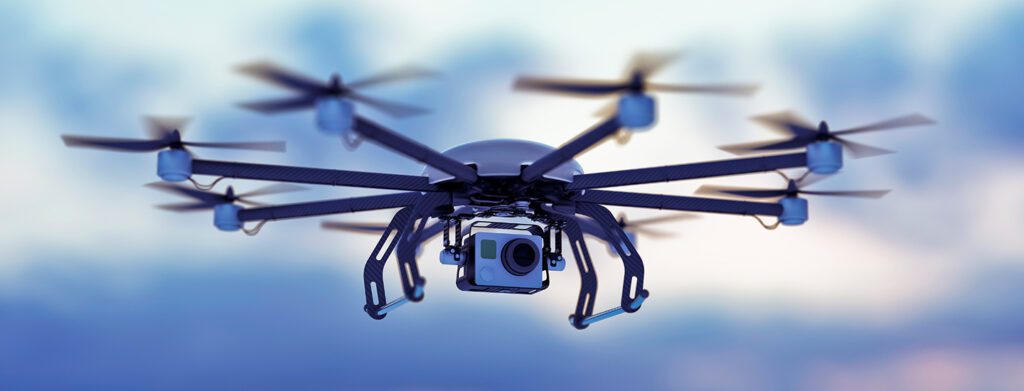Author
The low-cost of buying and operating remotely piloted aircraft (drones) for commercial use has opened up a world of opportunity. The technology, catapulted by developments in military drone use, has overtaken the current legal and regulatory framework, leaving significant gaps of knowledge and new risks to manage.
Drone users must ensure they comply with the existing regulatory regimes which apply to their use, and be aware of the likely developments. The regulatory world will catch up and drone pioneers must prepare for a legislation and bylaw backlash.
Why are we using drones?
Drones are being used for wide and varied commercial uses including the aerojournalism, police surveillance and geographic mapping.
The use of drones to map and collect data will also provide a deluge of data which will be of great value to business beyond the real-time use for the drone.
There are also novel opportunities for entrepreneurs; a company already offers a post-cremation drone service to scatter ashes, and new calls from the likes of Amazon Prime Air and Googles’ Project Wing for specific air routes to allow for direct to door ecommerce deliveries.
What are the legal issues?
Civil Aviation Regulation
More drones flying mean that the risk of collision is inevitably enhanced – between March 2014 and March 2015, the UK Civil Aviation Authority (CAA) recorded six ‘near misses’ where a drone came within 20ft of an airliner. Globally a similar picture emerges.
The correct regulation of drones falls within the remit of the Civil Aviation Authority (CAA) in the UK, but the degree of regulation currently depends on the weight and use of the aircraft.
Drones weighing 20kg or less – are…
classified as ‘Small Unmanned Aircraft’ (SUA) and are exempt from the majority of regulations that would normally apply to manned aircraft – provided they are for domestic use.
The user must;
- Be able to maintain unaided visual contact with the SUA
- Not fly in restricted airspace or at a height of over 400ft.
Where SUA’s are equipped with a camera, regulations are tighter, they must not be flown over or within 150m of congested areas or assemblies of more than 1,000 persons or within 50m of vehicles, buildings, structures or persons.
Drones weighing over 20kg – are …
subject to strict rules, equivalent to those for manned aircraft, unless an exemption applies, pilots of drones weighing over 20kg must:
- obtain a Certificate of Airworthiness;
- register the drone on the UK Register of Civil Aircraft;
- obtain flight permission from the CAA;
- obtain an approved pilot qualification.
Criminal offence
Recklessly or negligently endangering an aircraft or any person in an aircraft is a criminal offence and The CAA has warned that pilots will face prosecution if they put the safety of other aircraft at risk. The first example of successful UK prosecution for drone offences was in 2014 when a man was fined for flying a drone fitted with a camera within 50m of Jubilee Bridge and within restricted airspace over a nuclear submarine facility..
Safety by design
The responsibility of safe drone use does not just fall on the user. Manufacturers have recognised the importance of technology in developing drone safety.
For example, Geo-fencing, is an on-board GPS and mapping system (also known as “cyber fences”) which prevents drones from flying into restricted airspace. There is a recognised need at the European Commission to encourage investment in technologies that are required to integrate drones into the aviation systems covering European airspace.
Data protection and privacy
Existing data protection and privacy laws, as well as criminal laws in respect of harassment, are designed to protect citizens’ fundamental rights such as the right to privacy and the protection of personal data.
One of the biggest challenges for commercial exploitation of drones is dealing with privacy and data protection which often give rise to public concern. The use of “surveillance” drones, especially by the police, leads to “Big Brother” concerns.
Data protection
While any user has the potential to infringe data protection law, the Information Commissioners Office (ICO) focuses on ensuring non-domestic drone users (as opposed to ‘hobbyists’) to comply with data protection legislation. The ICO has adapted guidance on the use of CCTV to take into account drones that are fitted with a camera. Personal data (data that enables the identification of a living individual) collected by drones for commercial use must be processed fairly and lawfully in accordance with the Data Protection Act 1998 (DPA)
Privacy
Drone users should also be aware that improper drone use may infringe privacy, breach confidentiality or even harass others. By way of an example, it is possible that footage identifying a neighbour in their garden may infringe that person’s right to privacy if published. The risk of infringing privacy is likely to be reduced if inclusion of footage of that person is only incidental, for example at a sporting event
The health and safety risks
The potential for drones to cause personal injury and damage to property is likely to be considered less significant when compared with the risks posed by manned aircraft, but with an increase in flights, health and safety risks (and the risk of negligence claims) should be considered. The personal injury risks of drones were recently highlighted when Enrique Iglesias sliced his fingers open and fractured his hand attempting to hold onto a camera-carrying drone during one of his performances – and no doubt injuries to children and hobbyists are commonplace.
Safety by design
As with aviation risks, manufacturers are also taking steps to improve drones from a health and safety perspective. Health and safety guidelines will require that drones and their packaging are accompanied with adequate warnings and user instructions. An automatic ‘Return to Home’ feature triggers the return of the drone and automatic landing where battery life reaches 10% is built into the latest quadcopter drones, meaning that drones should not be in a position where they drop out of the skies when power fails.
Regulation for the future?
Current UK regulation of drones under the specific civil aviation rules coupled with the application of existing privacy laws is relatively clear-cut, although there are uncertainties in the approach to enforcement of those laws, and how they will cope with the explosion of use. The civil aviation rules will surely develop and change. The launch of a US publication ‘Drone Law Journal’ gives us some indication of the growth in this ‘aerial legal minefield’.
The European Commission suggested that safety rules, including on remote pilot and operator qualifications, should be developed by the European Safety Agency and further that the requirements should be harmonised at a global level. The thrust of the declaration is to protect drone users and manufacturers from a complex web of new rules and regulations stunting the growth of the industry, while enhancing public confidence and safety.
Businesses that want to take advantage of the opportunities drones can bring, should work with their legal advisors to understand current legal requirements but also plan for the inevitable future legal developments. A new ‘Law of Drones’ is already on the horizon.
For further information, please contact Tom Torkar at tom.torkar@michelmores.com or 01392 687626
SWDigital Forum
The next SWDigital Forum at Michelmores will be discussing the law of Drones and commercial opportunities.
Date: Tuesday 17 November 2015
Time: 12pm – 2.30pm
Cost: Free of charge – limited spaces
Venue: Woodwater House, Pynes Hill, Exeter EX2 5WR
To register your interest in the next SWDigital Forum please contact Naomi Morris on 01392 687655 or events@michelmores.com, or join the linkedin forum South West Digital Forum

